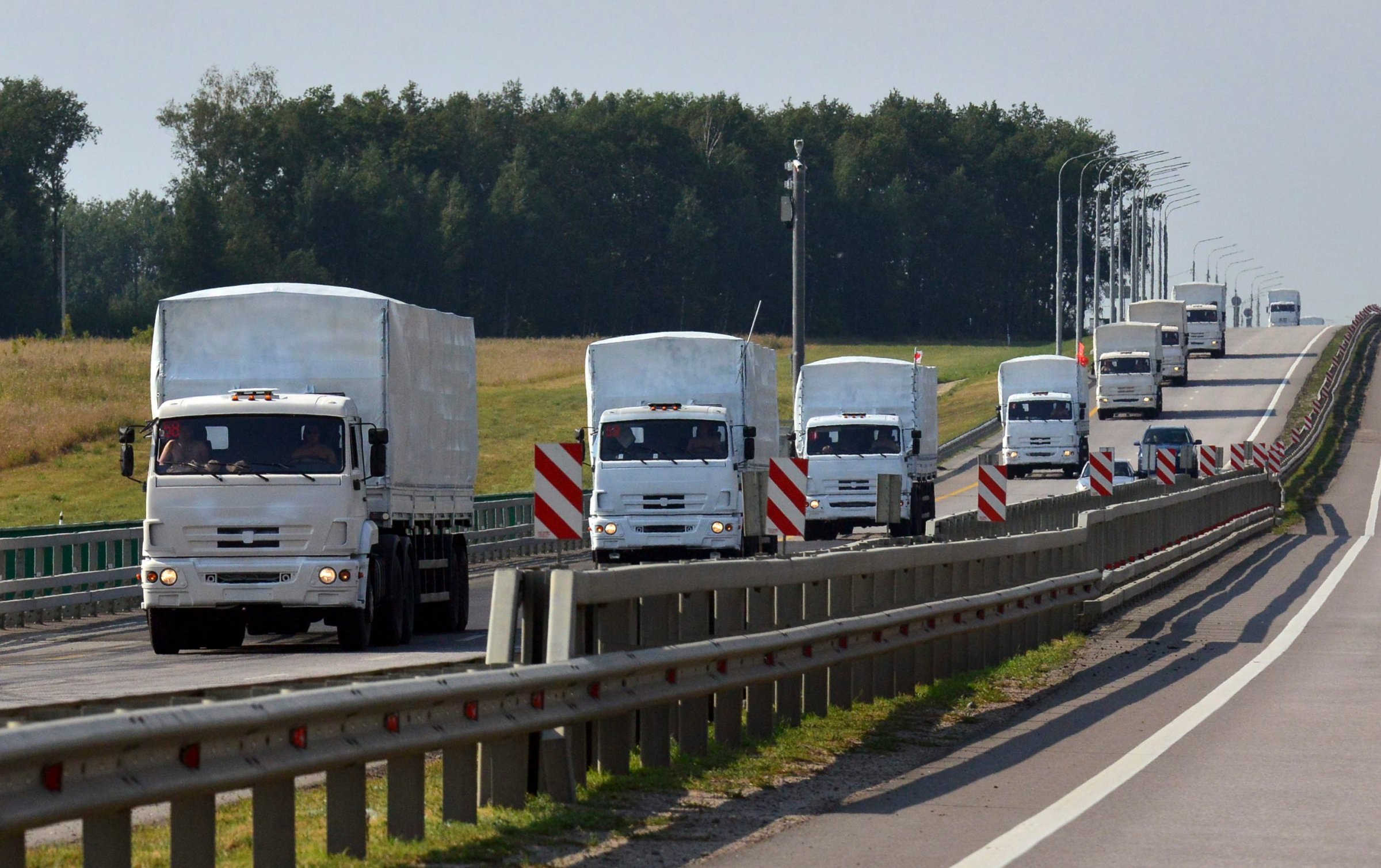
When the Russian convoy of nearly 300 trucks departed from a military base near Moscow on Tuesday morning and headed toward the border with Ukraine, they were kitted out to look as benevolent as possible. All of them were painted in pristine white, and matching tarpaulin was stretched over their cargo. As they prepared to head out, a priest went around and sprinkled their engines with holy water as television cameras rolled. But the nicest touch was applied to the drivers, whose identical knee-high shorts and khaki caps made them look like postal deliverymen.
The show was not entirely convincing. After all of Russia’s efforts to stoke the conflict in eastern Ukraine since it began in March – including supplying the separatist militias fighting the Ukrainian military with weapons and volunteers – it was hard for Ukraine to take seriously Russia’s claim that these trucks were carrying nothing more dangerous than baby food and power generators. Nor did the West give Moscow the benefit of the doubt. Before the trucks were even loaded, let alone inspected, the U.S. and its allies warned that the convoy was a wolf in sheep’s clothing, and the government in Kiev pledged on Tuesday that it would not be allowed to pass.
Both reactions could backfire. The goal of this convoy, though likely a lot more complicated than simple humanitarian aid, has more to do with domestic Russian politics than military strategy. Between June and July, the proportion of Russians who support a military incursion in eastern Ukraine has dropped from 40% to 26%, according to the independent Levada Center polling agency. But support for humanitarian aid to the region has meanwhile remained at around to 90% since May. “The Kremlin does not usually ignore this kind of consensus,” says Lev Gudkov, the director of the Levada Center. So President Vladimir Putin at least had to attempt a humanitarian mission.
And that’s likely all there is to the convoy, says Fyodor Lukyanov, a prominent foreign policy expert in Moscow. Putin hasn’t put his military aims aside, but knows that a phony aid convoy would be a poor way of achieving them. “It just wouldn’t make any sense,” he says. “Why would you mount such a grandiose and public spectacle with these trucks if you wanted to smuggle in weapons or start a war?”
Besides, the deception wouldn’t be necessary. Russia already has tens of thousands of troops gathered at the border with Ukraine, and if Putin gave the order, they could mount an invasion in a matter of hours while still maintaining some element of surprise. Nor would Putin need any trickery in order to funnel support to the separatist rebels. Their militias already control huge chunks of the border, and Russia has had no problem sending weapons and fighters across it without the use of subterfuge.
So the West’s anxiety over this column of trucks has seemed overblown. On Aug. 8, when Russia proposed its humanitarian mission during a meeting of the UN Security Council, the American ambassador to the UN warned that it would “be viewed as an invasion” if Russia acted unilaterally. “At every step in this crisis, Russians have sabotaged peace, not built it,” said Samantha Power. The day before the convoy set out, Anders Fogh Rasmussen, the head of the NATO military alliance, said in an interview with Reuters that there is a “high probability” of Russia invading Ukraine, potentially “under the guise of a humanitarian operation.”
The following day, as the convoy made its way to the border, the government in Kiev announced to no one’s surprise that they would not allow it to pass. “We will not consider any kind of movements of Russian convoys on Ukrainian territory,” said Valery Chaly, the deputy head of the presidential administration. “It would be disturbing to allow Russian trucks into Ukraine even without their drivers.” If the cargo indeed contains humanitarian aid, he added, it would need to be offloaded and moved onto Red Cross trucks before entering Ukraine.
The optics of that kind of traffic jam would play right into the Kremlin’s favorite narrative. On the one side would be the Russian convoy waiting to provide assistance to the victims of war, and on the other would be the Ukrainian military trying to block it. All the Western warnings of a Russian Trojan horse would also start to look a bit paranoid. “This is very smart on Putin’s part. It allows him to call the West’s bluff,” says Matthew Rojansky, an expert on Russia and Ukraine at the Wilson Center in Washington. “He is calling out this hyperbolic position that everything Russia does is aggressive and counterproductive.”
Most of the time that position has been right. Russia’s actions in Ukraine have indeed been aggressive since the conflict began in March, and its support for the separatists in eastern Ukraine has been anything but productive for the cause of peace. But the humanitarian convoy appears to be one of the few exceptions to the rule. It would have allowed Putin to save face among his own electorate, answering the public calls for a Russian aid mission to eastern Ukraine. Achieving that now looks impossible without the use of military force, and whether or not Putin wanted that outcome, the West’s mistrust has brought him closer to it.
More Must-Reads from TIME
- Cybersecurity Experts Are Sounding the Alarm on DOGE
- Meet the 2025 Women of the Year
- The Harsh Truth About Disability Inclusion
- Why Do More Young Adults Have Cancer?
- Colman Domingo Leads With Radical Love
- How to Get Better at Doing Things Alone
- Michelle Zauner Stares Down the Darkness
Contact us at letters@time.com